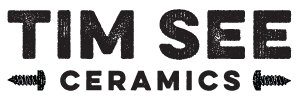My explorations in surface design on wood-fired stoneware shifted toward darker surfaces with frames around the hand-painted illustrations becoming a more pronounced part of the decoration. Those frames kept their industrial origins but became curvaceous, almost tribal, in appearance, and, on some pots, more elaborate.
For reasons as yet unexplained, the Bucketheads decided to go to Mars. Five Bucketheads with a payload of robotic octopus boarded a rocket and set off. These steam-bowered Bucketheads planned to use the mechanical octopi as an energy source. Since there is no oxygen on Mars to power the production of steam, the octopi were designed to pulverize the iron-rich rock of Mars to release the oxygen.
Unbeknownst to them however, an evil Buckethead had messed with the mechanical systems in the rocket before they even left Earth, which caused them to crash land on Mars. Four Bucketheads and all but one of the octopi, were destroyed. The remaining Buckethead, now nicknamed Chuthulu, a resourceful builder with a strong will to exist, hatched a plan with the lone octopus, Seefal. By harvesting parts from the destroyed Bucketheads, Chuthulu created a transport vehicle to head back to Earth. In order to be powered up for the journey, Chuthulu needed to cannibalize parts of Seefal to both extract the oxygen from Mars rock and create an oxygen mask out of its tentacles for the ride home. In a desperate move, Chuthulu, preserved Seefal’s brain for possible placement in a new octopus body should they succeed in returning to Earth.
Chuthulu made it but the other Bucketheads do not celebrate the traveler’s return, choosing instead to ostracize Chuthulu for leaving behind its fellow travelers and the octopus carcasses.
The last image of this series is Chuthulu with Seefal perched on its shoulder; Chuthulu succeeded in creating a new octopus body for the octopus brain.

































